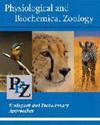Hypoxia Decreases Thermal Sensitivity and Increases Thermal Breadth of Locomotion in the Invasive Freshwater Snail Potamopyrgus antipodarum
IF 1.8
3区 生物学
Q3 PHYSIOLOGY
引用次数: 2
Abstract
Understanding the physiology of invasive species will contribute to better prediction and prevention measures to avoid the economic and environmental consequences of biological invasions. Predicting the future range of Potamopyrgus antipodarum, a globally invasive aquatic snail, relies on a comprehensive understanding of its physiological tolerances to individual and combined environmental stressors. We conducted a laboratory study to investigate the interacting effects of temperature and dissolved oxygen in shaping the abiotic niche of P. antipodarum. We generated thermal performance curves (7°C–35°C) for resting respiration rate and voluntary locomotor behaviors under normoxia and hypoxia to find the conditions that limited each performance. Extreme high (>30°C) and low (<12°C) temperatures limited respiration and activity, but respiration rate was most oxygen sensitive at low temperatures. Under hypoxic conditions, activity was less thermally sensitive. Increased activity under high temperatures (22°C–28°C) may be fueled by anaerobic metabolism. Relying on anaerobic energy is a time-limited survival strategy, so further warming and deoxygenation of freshwater systems may limit the spread of this very tolerant invasive species.低氧降低入侵淡水蜗牛的热敏性和增加运动的热宽度
了解入侵物种的生理学将有助于更好地预测和预防措施,以避免生物入侵的经济和环境后果。预测全球入侵水生蜗牛Potamopyrgus antipodarum的未来范围,取决于对其对个体和组合环境压力的生理耐受性的全面了解。我们进行了一项实验室研究,以研究温度和溶解氧在形成P.antipodarum非生物生态位中的相互作用。我们生成了常氧和缺氧条件下静息呼吸速率和自主运动行为的热性能曲线(7°C–35°C),以找出限制每种性能的条件。极端高温(>30°C)和低温(<12°C)限制了呼吸和活动,但呼吸速率在低温下对氧气最敏感。在缺氧条件下,活动对热的敏感性较低。高温(22°C–28°C)下活性的增加可能是由厌氧代谢推动的。依靠厌氧能源是一种有时限的生存策略,因此淡水系统的进一步变暖和脱氧可能会限制这种非常耐受的入侵物种的传播。
本文章由计算机程序翻译,如有差异,请以英文原文为准。
求助全文
约1分钟内获得全文
求助全文
来源期刊
CiteScore
3.20
自引率
6.20%
发文量
62
审稿时长
6-12 weeks
期刊介绍:
Physiological and Biochemical Zoology: Ecological and Evolutionary Approaches primarily publishes original research in animal physiology and biochemistry as considered from behavioral, ecological, and/or evolutionary perspectives. Studies at all levels of biological organization from the molecular to the whole organism are welcome, and work that integrates across levels of organization is particularly encouraged. Studies that focus on behavior or morphology are welcome, so long as they include ties to physiology or biochemistry, in addition to having an ecological or evolutionary context.
Subdisciplines of interest include nutrition and digestion, salt and water balance, epithelial and membrane transport, gas exchange and transport, acid-base balance, temperature adaptation, energetics, structure and function of macromolecules, chemical coordination and signal transduction, nitrogen metabolism and excretion, locomotion and muscle function, biomechanics, circulation, behavioral, comparative and mechanistic endocrinology, sensory physiology, neural coordination, and ecotoxicology ecoimmunology.

 求助内容:
求助内容: 应助结果提醒方式:
应助结果提醒方式:


